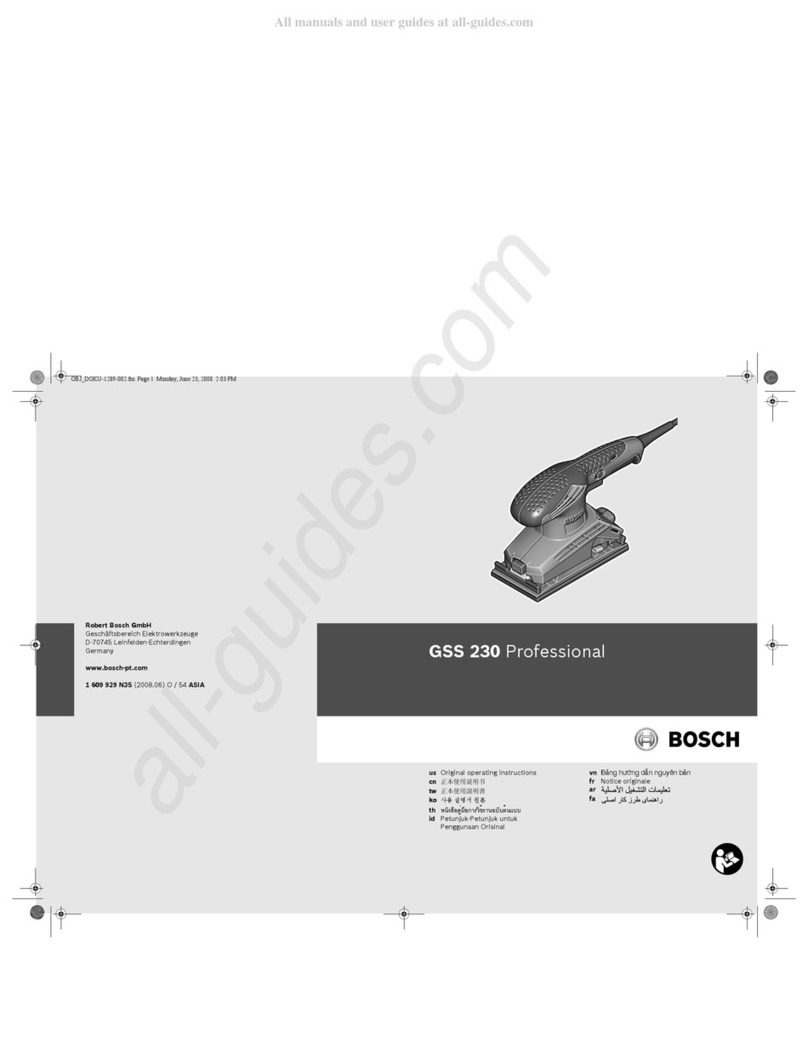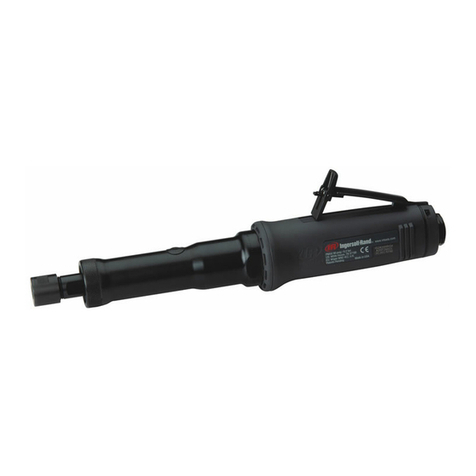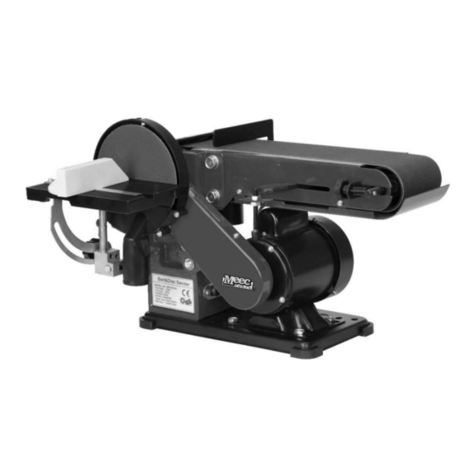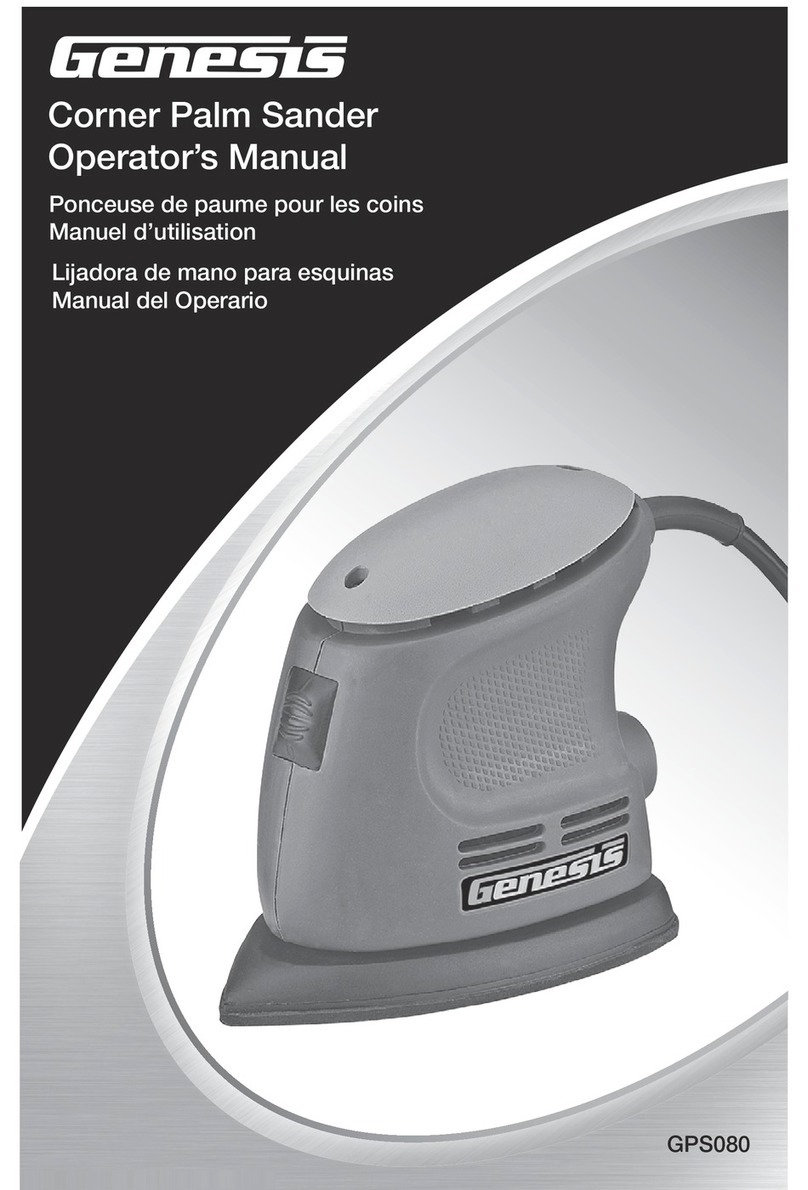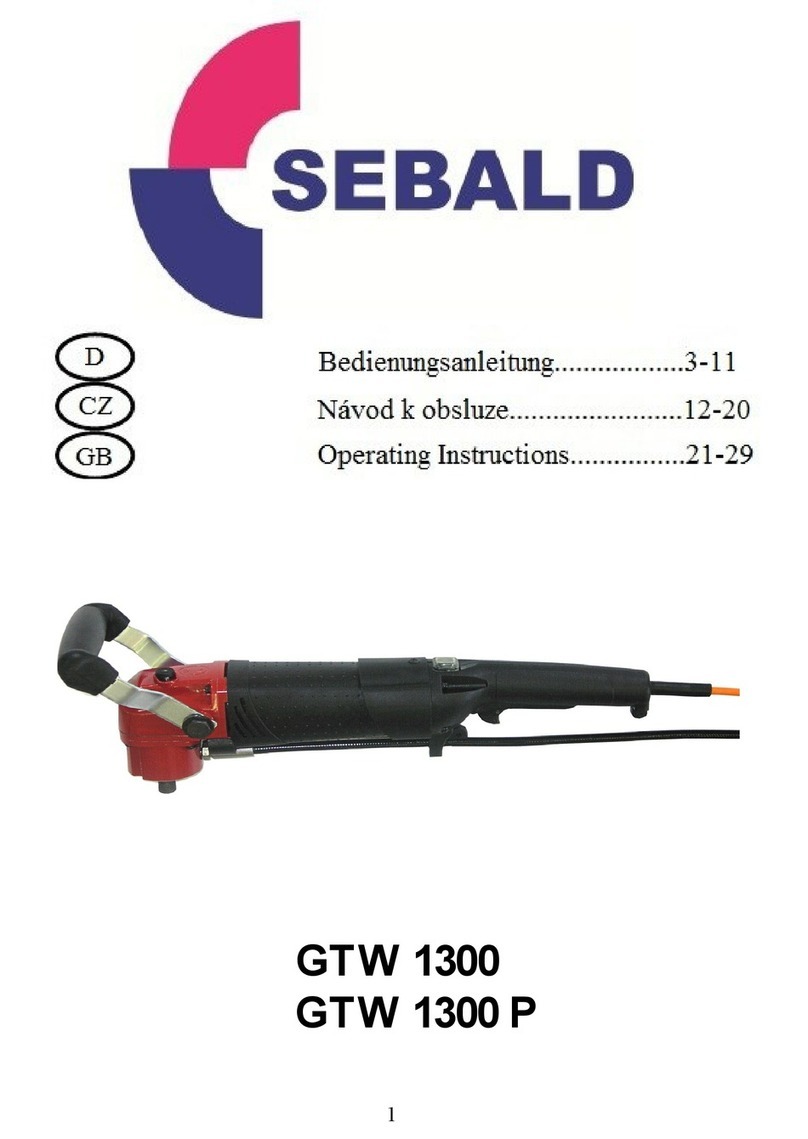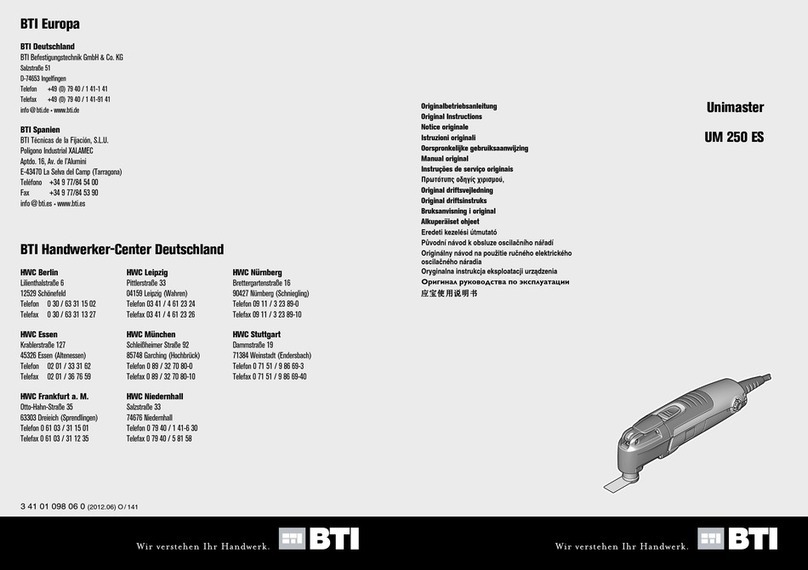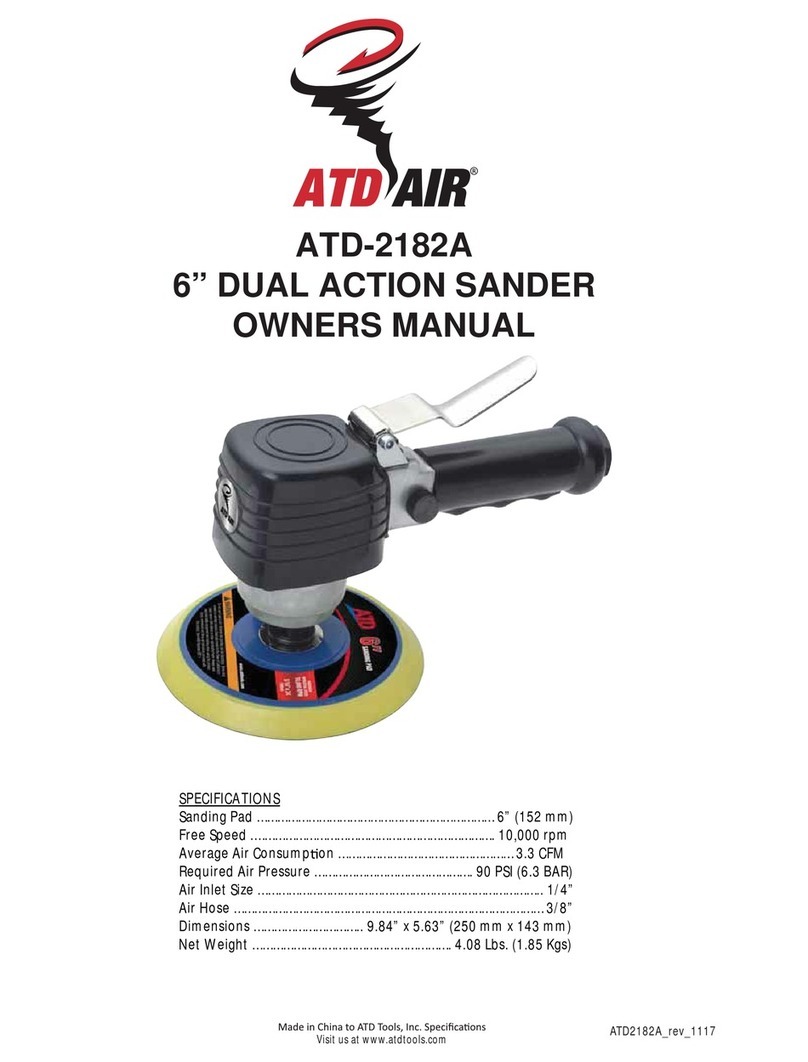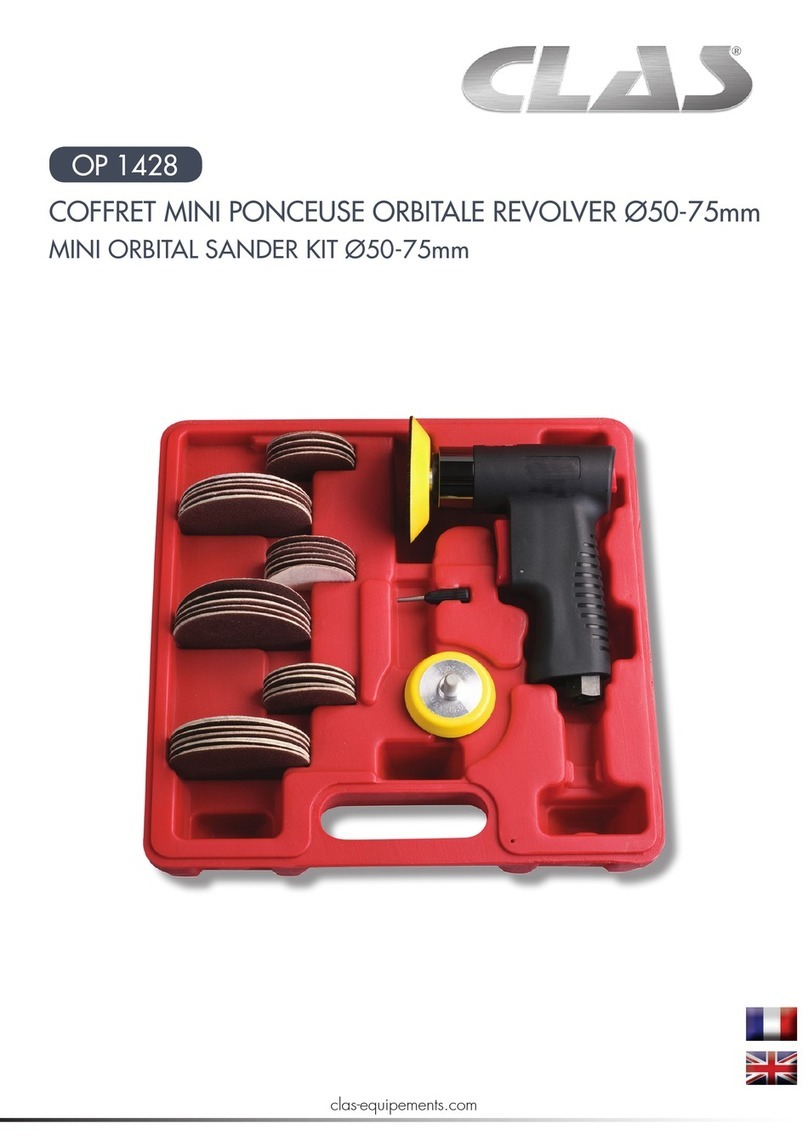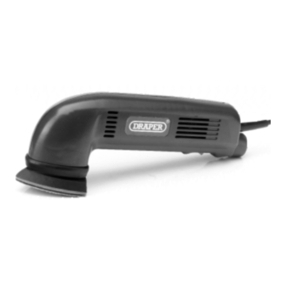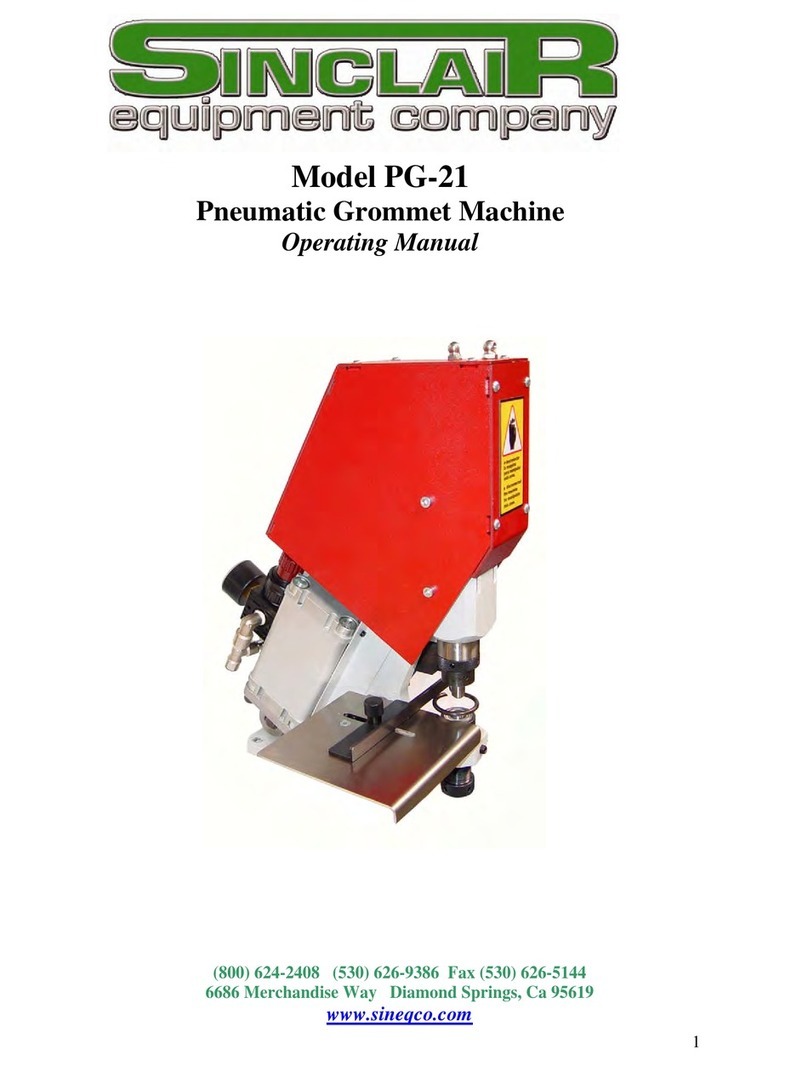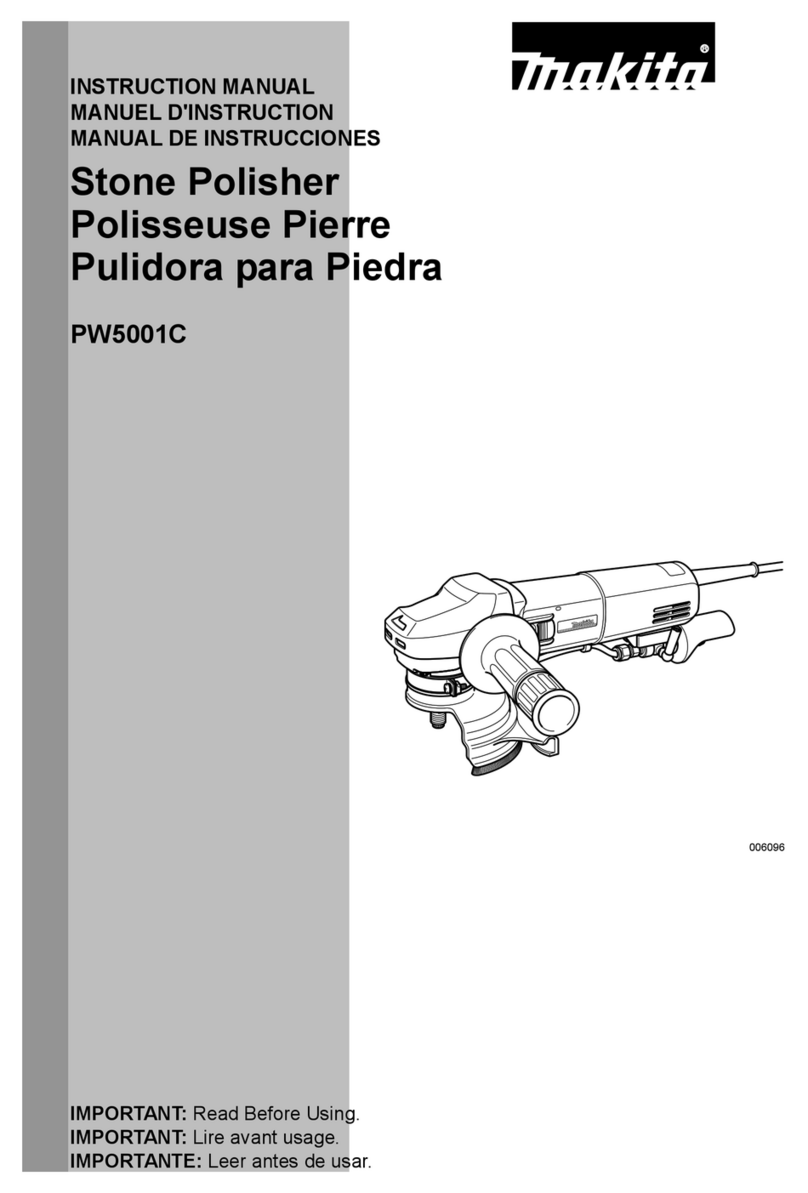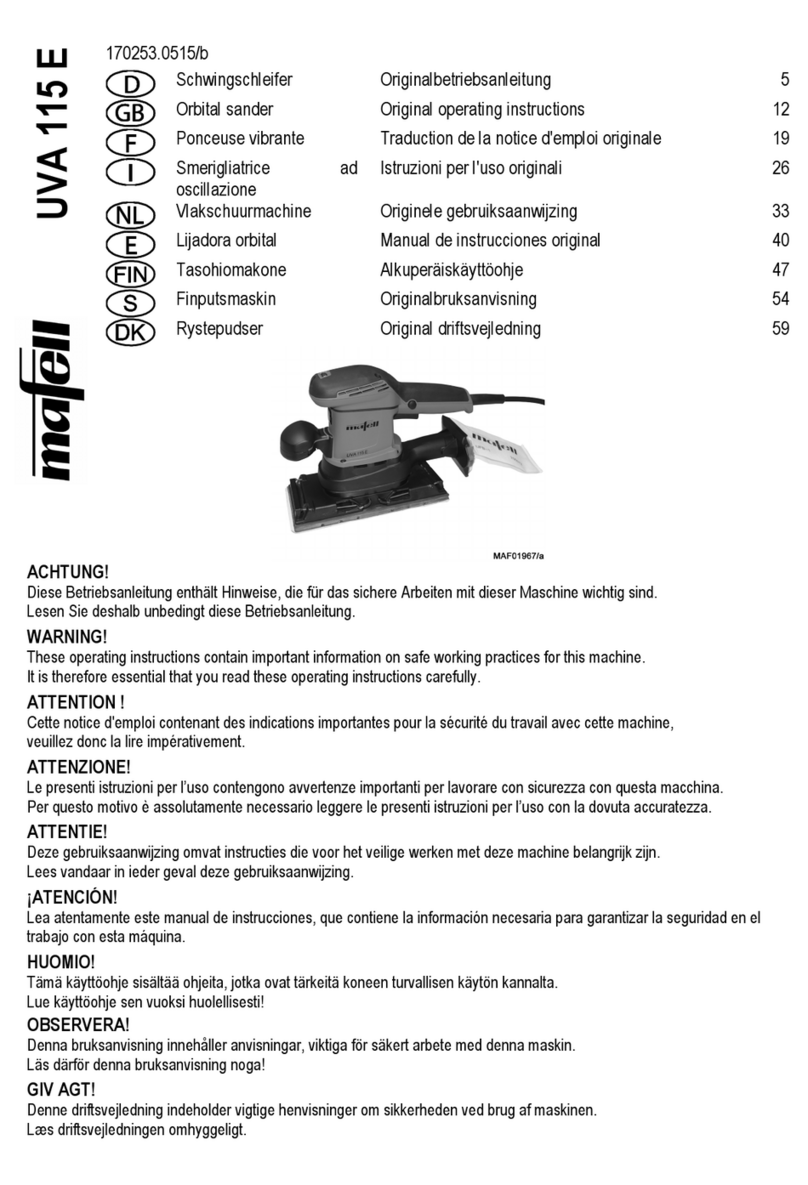Clarke American Sanders FloorCrafter 07104A User manual

Part No. LT068100 3/14
FloorCrafter
Belt Sander
U.S. Patent No. 5,575,710 and No. 6,578,858
Operator's Manual / Manual del operador / Manuel de l’utilisateur
Models: 07104A, 56380917
This book has important information for the use and safe operation of this machine. Failure to read this book prior to
operating or attempting any service or maintenance procedure to your Clarke American Sanders machine could result
in injury to you or to other personnel; damage to the machine or to other property could occur as well. You must have
training in the operation of this machine before using it. If your operator(s) cannot read this manual, have it explained
fully before attempting to operate this machine.
All directions given in this book are as seen from the operator’s position at the rear of the machine.
English (2 - 20)
Español (22 - 40)
Français (42 - 60)
READ THIS BOOK
LEA ESTE MANUAL
LISEZ CE MANUEL
ES
EN
FR

EN
ENGLISH
-2- Clarke®American Sanders Operator's Manual (EN) - Floorcrafter
Table of Contents
Operator Safety Instructions........................................................................................................ 3
Introduction and Machine Specications..................................................................................... 5
230V Electrical Connection Instructions...................................................................................... 6
How to Transport the Machine..................................................................................................... 7
One Person............................................................................................................................ 8
Two People ............................................................................................................................ 9
Machine Set-Up........................................................................................................................... 9
How to Operate the Machine......................................................................................................11
Sanding Cuts and Sandpaper ................................................................................................... 13
Chatter Wave Prevention .......................................................................................................... 14
Sander Adjustment Procedures................................................................................................. 15
Dust Shoe.............................................................................................................................. 15
Sanding Pressure.................................................................................................................. 15
Leveling the Drum ................................................................................................................ 15
Belt Tracking.......................................................................................................................... 16
Operating Control .................................................................................................................. 16
Routine Maintenance................................................................................................................. 17
Sanding Chamber.................................................................................................................. 17
Wheels................................................................................................................................... 17
Dust Bag................................................................................................................................ 17
Drive Belt............................................................................................................................... 17
Bearings ................................................................................................................................ 18
Rollers ................................................................................................................................... 18
Troubleshooting......................................................................................................................... 19
SECTION II Parts Manual
Base Assy............................................................................................................................. 62-63
Belt Tensioner Assy .............................................................................................................. 64-65
Dolly Assy............................................................................................................................. 66-67
Dust Control Assy................................................................................................................. 68-69
Handle Assy.......................................................................................................................... 70-71
Motor Assy................................................................................................................................. 72
Sanding Drum Assy................................................................................................................... 73
Wiring Diagram.......................................................................................................................... 74
WARNING!
The Products sold with this Manual contain or may contain chemicals that are known to certain governments (such as the State of
California, as identied in its Proposition 65 Regulatory Warning Law) to cause cancer, birth defects or other reproductive harm. In
certain locations (including the State of California) purchasers of these Products that place them in service at an employment job site or
a publicly accessible space are required by regulation to make certain notices, warnings or disclosures regarding the chemicals that are
or may be contained in the Products at or about such work sites. It is the purchaser’s responsibility to know the content of, and to comply
with, any laws and regulations relating to the use of these Products in such environments. The Manufacturer disclaims any responsibility
to advise purchasers of any specic requirements that may be applicable to the use of the Products in such environments.

EN
ENGLISH
Clarke®American Sanders Operator's Manual (EN) - Floorcrafter - 3 -
OPERATOR SAFETY INSTRUCTIONS
WARNING AVERTISSEMENT ADVERTENCIA
DANGER means: Severe bodily injury or death can occur to you or other personnel if the DANGER statements
found on this machine or in this Operator’s Manual are ignored or are not adhered to. Read
and observe all DANGER statements found in this Operator’s Manual and on your machine.
WARNING means: Injury can occur to you or to other personnel if the WARNING statements found on your
machine or in this Operator’s Manual are ignored or are not adhered to. Read and observe all
WARNING statements found in this
Operator’s Manual and on your machine.
CAUTION means: Damage can occur to the machine or to other property if the CAUTION statements found
on your machine or in this Operator’s Manual are ignored or are not adhered to. Read and
observe all CAUTION statements found in this Operator’s Manual and on your machine.
DANGER: Failure to read the Operator’s Manual before operating or servicing this sanding equipment could result in
injury to the operator or to bystanders and could cause damage to the equipment. Read and observe all
safety statements found in this manual and on the sanding equipment. Make sure all labels, decals, warn-
ings, cautions and instructions are fastened to the equipment. Replace any that are damaged or missing.
You must have training in the operation of this equipment before using it. If the operator is unable to read
this manual, have it explained fully before they attempt to use this equipment.
DANGER: Sanding/nishing wood oors can create an environment that can be explosive. The following safety proce-
dures must be adhered to:
• Cigarette lighters, pilot lights and any other source of ignition can create an explosion when active during
a sanding session. All sources of ignition should be extinguished or removed entirely if possible from the
work area.
• Work areas that are poorly ventilated can create an explosive environment when certain combustible
materials are in the atmosphere, i.e., solvents, thinners, alcohol, fuels, certain nishes, wood dust and
other combustible materials. Floor sanding equipment can cause ammable material and vapors to burn.
Read the manufacturer’s label on all chemicals used to determine combustibility. Keep the work area well
ventilated.
• Spontaneous combustion or an explosion can occur when working with sanding dust. The sanding dust
can self-ignite and cause injury or damage. Sanding dust should be disposed of properly. Always empty
the sanding dust into a metal container that is located outside of any building(s).
• Remove the contents of the dust bag when the bag is 1/3 full. Remove the contents of the dust bag each
time you nish using the equipment. Never leave a dust bag unattended with sanding dust in it.
• Do not empty the contents of the dust bag into a re.
• Hitting a nail while sanding can cause sparks and create an explosion or re. Always use a hammer and
punch to countersink all nails before sanding oors.

EN
ENGLISH
-4- Clarke®American Sanders Operator's Manual (EN) - Floorcrafter
DANGER: Operating partially assembled sanding equipment could result in injury to the operator or bystander and could
cause damage to the equipment or to other property.
• Do not operate this equipment unless it is fully assembled and all guards, doors and covers are secured.
• Keep all fasteners tight.
• Keep all adjustments within manufacturers specications.
DANGER: Moving parts on this sanding equipment can cause injury to the operator or bystanders.
• Keep hands, feet and loose clothing away from all moving parts.
• Do not change or adjust the abrasive while the sanding equipment is running.
• Do not service the sanding equipment while it is running.
DANGER: This sanding equipment requires a supply of electricity. Improper use could result in electrical shock or re.
• Connect only to an electrical source matching what is shown on the equipment nameplate.
• Do not use this sanding equipment on an ungrounded electrical circuit. Consult an electrician if you suspect the
circuit is not properly grounded.
• Do not use this sanding equipment with a damaged electrical cord. Inspect before each use.
• Avoid striking the electrical cord with the abrasive. Always lift the electrical cord over the sanding equipment.
• Do not use the electrical cord to move the sanding equipment.
• Disconnect the electrical source before servicing this equipment.
WARNING: In the event of a bag re, injury can occur to the operator if the operator is tied or strapped to equipment. Use operat-
ing belt properly (follow procedure on page 11).
WARNING: Injury to the operator or bystander can occur if protective gear is not worn while sanding. Always use eye, ear, and
respiratory protection while performing any sanding operation.
WARNING: Bodily injury could occur if power is applied to the equipment with the power switch already in the “ON” position.
Always check to assure that the power switch is in the “OFF” position before connecting power supply.
CAUTION: Maintenance and repairs performed by unauthorized personnel could result in damage or injury. Maintenance and
repairs performed by unauthorized personnel will void your warranty. Servicing of this unit must always be referred
to an authorized Clarke American Sanders distributor.
CAUTION: Use of this equipment to move other objects or to climb on could result in injury or damage. Do not use this equip-
ment as a step or furniture. Do not ride on this equipment.
CAUTION: Damage could occur to the equipment if not properly kept in a dry building for storage. Store the equipment in a
dry building.
CAUTION: The equipment is heavy. When transporting the equipment, remove the motor. Get help to lift the equipment and
motor.
CAUTION: Serious damage to the oor can occur if the sanding equipment is left running in one spot while the sanding drum
is in contact with the oor. To avoid damage to the oor, feather cut in at a normal sanding rate. Do not dwell while
lowering or raising the contact wheel. Always sand at a constant rate.

EN
ENGLISH
Clarke®American Sanders Operator's Manual (EN) - Floorcrafter - 5 -
Introduction and Machine Specications
MODEL 07104A 56380917
Electrical Requirements 230~, 60Hz / 15.7 A, 3.7 kW 230~, 50Hz / 16.0 A, 3.0 kW
Sound Emisson (Lpm) 93.0 dB(A) 96.2 dB(A)
Vibration <.15 in/s 2.88 m/s2rms
Motor 4 Hp Induction 3 kW Induction
Contact Wheel Rate 2450 rpm 2042 rpm
Abrasive Rate 4500 ft/min 3750 ft/min
Abrasive Size 29½” x 77/8”29½” x 77/8”
Fan Flow Rate 234 CFM 195 CFM
Drum Settings 80 lbs., 70lbs., 60 lbs. 80 lbs., 70lbs., 60 lbs.
Overload Protection Magnetic Circuit Breaker Magnetic Circuit Breaker
Electrical Cable 50’, 10-3 SJO LP-20P Plug 100’, 12-3 SJO AU2-15P Plug
Operating Controls Adjustable Lever/Grip Adjustable Lever/Grip
Leveling Controls Externally Adjustable Externally Adjustable
Operating Wheels 80 Durometer Clear Urethane 80 Durometer Clear Urethane
Weight 204 lbs. 204 lbs.
Dimensions 35 x 133/4 x 383/435 x 133/4 x 383/4
CAUTION: Your equipment may be inappropriate on some installations. Some softer woods used in oor-
ing cannot support the pressure created by hard wheels.
Always consult with the ooring manufacturer on the proper installation, preparation, and nish-
ing of their product. Determine suitability of your equipment in preparing the product.

EN
ENGLISH
-6- Clarke®American Sanders Operator's Manual (EN) - Floorcrafter
Figure 1
230V Electrical Connection Instructions
CAUTION: This machine will operate only on AC fre-
quency and on electrical voltage shown on
the equipment nameplate. Make sure you
have the correct frequency and voltage be-
fore connecting the power cord to an out-
let. See the example in gure 1.
This machine must be connected to an electrical source with an
earthing conductor in order to protect the operator from electric
shock. This machine has an approved power cord with three con-
ductors as well as a plug with three terminals. Connect the plug to
a matching receptacle.
DANGER: Electrocution could occur if the machine
is exposed to water or rain. Keep the ma-
chine in a dry building.
DANGER: Electrocution could occur if machine is not
connected to an electrical source with an
earthing conductor. To prevent possible
electric shock, use an electrical cord with
an earthing conductor and connect it to a
matching electrical source. For maximum
protection against electrical shock, use a
circuit that is protected by a ground fault
circuit interrupter. Consult your electrical
contractor.
DANGER: Electrocution could occur if the machine is
used with a damaged plug or power cord.
If the cords or plugs are worn or damaged
in any way, have them replaced by an au-
thorized service person or electrician.
Extension Cords
Use only an approved three-pronged extension cord with two main
conductors and one earthing conductor. This machine is equipped
with a power cord. When greater range is needed follow the table
below to determine cable gauge of additional footage. Refer to the
chart to the right for extension cord information.
If motor appears to labor or takes a considerable longer time to
come up to speed reduce sanding pressure. Feet/Wire Gauge (Stranded Copper)
Source Voltage 0 - 100’ 100 - 250’
208 6 Use Voltage Booster
230 10 8

EN
ENGLISH
Clarke®American Sanders Operator's Manual (EN) - Floorcrafter - 7 -
Figure 4
Figure 3
Figure 2
AB BA
How to Transport the Machine
WARNING: The machine is heavy. Remove the motor
from the machine before transporting. Get
help loading the machine and motor. Use
proper lifting techniques.
Transporting the Machine - Using the Dolly Cart
CAUTION: When deploying the dolly, the drum will
contact the oor or ground over which the
machine is resting. Care should be taken
to avoid surfaces which might damage or
contaminate the drum.
CAUTION: While transporting using the dolly, abrupt
changes in the direction of travel or the
surface over which the machine is being
transported could cause the machine to tip
over. Also, the machine is more likely to
tip over when transporting across inclined
surfaces.
Attach the dolly to the rear of the machine as follows:
1. Open the quick release levers (2A) and unscrew the adjustment
nuts (2B) to allow installation of the dolly. (See gure 2)
2. Insert the quick release skewers into the dolly brackets and
immediately tighten the adjustment nuts until the dolly mechanism
will just swing free.
Deploy the dolly under the machine as follows:
1. With the dolly mechanism in place as described above, tip the
machine by lifting up on the operators handle to raise the rear of
the machine off the oor/ground until the dolly swings under the
machine. (See gure 3)
2. Hold the dolly in position using your foot and allow the machine to
tip back and rest on the dolly wheels. (See gure 4)
3. Tip the machine back on all four wheels and close the quick
release levers for transport. Some adjustment of the quick
release skewers may be necessary to allow the levers to be
tightened securely.
Removing/Storing the dolly:
The dolly can be stored on the machine in the “UP” position or it can
be removed and stored separately.
1. Open the quick release levers to loosen the dolly.
2. Lift up on the operators handle to tip the machine forward.
3. Swing the dolly out from under the machine and lower the
machine until it rests on its own wheels.
CAUTION: Be careful when lowering the machine.
The dolly will swing back toward the
operator as the machine is lowered.

EN
ENGLISH
-8- Clarke®American Sanders Operator's Manual (EN) - Floorcrafter
Figure 5
A
B
Figure 6
Figure 7
Figure 8
How to Transport the Machine
4. To store the dolly in the “UP” position, swing the dolly up against
the top of the mainframe as far as it will travel and close the quick
release levers to secure it in place. (See Figure 5)
5. To remove the dolly, loosen the quick release adjustment nuts
until the levers and nuts clear the counter-bore on the dolly
brackets, and remove the dolly.
6. Tighten the adjustment nuts until the quick release levers can be
closed to secure the dolly in place.
Transporting the Machine - One Person
NOTE: This is accomplished by removing the motor from the chassis
and transporting the motor and chassis separately.
To transport the machine, follow this procedure:
1. Make sure the power cable is disconnected from the electrical
outlet.
2. Release the tension on the drive belts using the quick release
lever. (See Figure 6A )
3. Open the belt guard by pulling on the handle immediately above
the left truck wheel. (See Figure 6B)
4. Remove the drive belts from the machine
5. Disconnect the motor pigtail from the handle pigtail.
(See Figure 7) if so equipped.
6. Unscrew the motor mounting knobs to loosen the motor. (See
Figure 8)
7. Straddle the motor and grasp the motor lift handle. Using your
legs, lift the motor off the chassis and take it to the work site.
8. Lift the chassis by grasping the front and rear handles. Lift the
frame and bring the belt guard against your chest. Take the
chassis to the work site.
To assemble the machine after transporting, follow this procedure:
1. Open the belt guard door. Place the motor assembly on the
chassis and screw the motor mounting knobs sufciently to
engage and secure the motor.
2. Install the drive belts. Tighten the belts using the belt tension
quick release lever.
3. Check the tension on the belts and close the belt guard door.

EN
ENGLISH
Clarke®American Sanders Operator's Manual (EN) - Floorcrafter - 9 -
Figure 9
Figure 10
Figure 11
How to Transport the Machine
CAUTION: Premature bearing failure can occur if the
fan belt is set too tight. The fan belt should
deect ½” at the center of the span with 5
lbs. of pressure.
NOTE: It is necessary to adjust the fan belt independently during this
procedure or during replacement. The idler pulley is factory adjusted.
Transporting the Machine by Carrying - Two People
1. Person #1 places his hands under the front of the machine’s main
casting.
2. Person #2 lifts the machine by the operating handle.
Machine Set-Up
To set-up your machine, follow this procedure:
1. Familiarize yourself with the machine and read all danger,
warning and caution statements. Make sure all operators of this
machine have read this Owner’s Manual. If they cannot read this
manual, have the manual explained fully before allowing anyone
to operate the sander.
2. Locate the electrical source. The receptacle should be
compatible with the plug. The receptacle must be grounded and
must be fused (see nameplate for electrical requirements) to
avoid an electrical hazard.
3. Clip the dust bag to the elbow. (See gure 9) Cross the strings
on the dust bag and draw tight over the are on the elbow. Wrap
the string around the elbow and secure.
4. Wind the electrical cord through the cable arm.
(See gure 10) Keep the power cord out of path of equipment.
Do not connect the electrical cord at this time.
5. Pull the draw latch forward to release the access door to gain
entry to the sanding chamber.
6. Rotate the release lever forward. (See Figure 11)

EN
ENGLISH
-10- Clarke®American Sanders Operator's Manual (EN) - Floorcrafter
Figure 12
Machine Set-Up (Cont)
7. Install a new abrasive belt by sliding the abrasive over the
tension roller and contact wheel.
(See gure 12)
8. Rotate the release lever backward to tighten the abrasive belt.
CAUTION:
Do not force the release lever. Doing so can
damage the tracking mechanism and cause
the abrasive belt to mis-track.
9. Depending on the model, the control switch is found on either
the operating handle or on the motor. Verify that the control
switch is set to “OFF”. See the marking on the switch.
10. Connect the electrical cord. On certain models, the connection
must be twisted clockwise to lock.
11. Jog (turn on momentarily - test operation) the control switch
while observing the belt tracking. Follow the procedures
outlined in the “Sander Adjustment Procedures” on page 16 to
correct the belt tracking. There is also a label on the inside of
the access door that outlines the belt adjustment.
12. Close the access door. Place the end of the draw latch over
the keeper on the access door and push the draw latch at
against the mainframe to secure.

EN
ENGLISH
Clarke®American Sanders Operator's Manual (EN) - Floorcrafter - 11 -
How to Operate the Machine
DANGER: Sanding/nishing wood oors can
create an environment that can be
explosive. Cigarette lighters, pilot
lights and any other source of ignition
can create an explosion when active
during a sanding session. All sources
of ignition should be extinguished or
removed entirely if possible from the
work area.
DANGER: Work areas that are poorly ventilated,
can create an explosive environment
when certain combustible materials
are in the atmosphere, i.e., solvents,
thinners, alcohol, fuels, certain
nishes, wood dust and other
combustible materials. Floor sanding
machines can cause ammable
material and vapors to ignite. Read the
manufacturer’s label on all chemicals
used to determine combustibility.
Keep the work area well ventilated.
DANGER: Sanding dust can self ignite and
cause an injury or damage. Remove
the contents of the dust bag each
time you nish using the machine.
Always dispose of the dust in a
metal container located outside of
the building. Never leave a dust bag
unattended with sanding dust in it.
Empty the contents frequently. Do not
empty the contents of the dust bag into
a re.
DANGER: Hitting a nail while sanding can cause
sparks and create an explosion or re.
Always use a hammer and punch to
countersink all nails before sanding
oors.
To operate the machine follow this procedure:
1. Before sanding, decide on best approach for sanding
desired area. If the oor is uneven, it may be necessary to
sand diagonally to the direction that the oor is laid. This
will help “pull” or stretch low and high spots in the oor over
a greater area, producing a atter surface.
Preliminary cuts should be performed at angles
approximately 15° to the direction of the wood grain. Cut
direction should change on successive cuts with the nal
cut performed in the direction of the wood grain. This will
minimize the tendency of waves to form and provide the
most even oor surface.
When sanding the area, work in a way so that you are
moving away from where the cord set enters the room.
This will help to avoid entanglement with the cord set and
eliminate the need to move the cord set out of the way so
frequently.
Work the area in a way that avoids interruption or
termination points (an end of pass.) Make long continuous
passes.
2. Swing cable arm to side of machine opposite the direction
you intend to work. Rotate elbow on dust pipe until dust
bag rest on motor. This will maintain balance and sanding
pressure as the dust bag lls. The machine should be
operated with the dust bag in this position whenever
possible.
3. If the operating belt (Clarke American Sanders PN 60724A)
is used proceed as follows:
a. Position the operating belt around waist.
b. Cross the straps at the waist. See gure #13.
c. Slide the belt loop end over the handle on the control
lever side. Adjust the length as needed.
d. Wrap the remaining strap around the opposite side of
the handle, and hold it in place with your hand.
WARNING: Serious operator injury could occur if the
operator has tied or strapped the loose end
of the operator’s belt strap to the machine.
Always wrap the strap so that you can let
go and get away quickly in case of bag re
or explosion.
4. Activate the control switch.
CAUTION: To prevent damage to the oor, make sure
the machine is in motion when the contact
wheel is engaged with the oor.
5. Feather-cut in by easing the contact wheel down onto the
surface with the control lever while the sander is in motion.

EN
ENGLISH
-12- Clarke®American Sanders Operator's Manual (EN) - Floorcrafter
Figure 13
How to Operate the Machine
6. When contact wheel is fully engaged with the surface,
gradually adjust your pace for adequate nish removal.
Keep sander in motion while the contact wheel is
engaged with the surface or dwell marks will occur.
7. Move the machine in the direction of the grain in the wood
whenever it is possible. Sand the surface at a constant
pace.
8. Gradually feather-cut out at the termination point by
easing the contact wheel up with the control lever. (See
Figure 13)
9. Repeat technique described in steps 5, 6, 7, and 8 and
sand back down pass just made. When completed, begin
a new pass by overlapping previous pass half the width
of the abrasive. Stagger termination points to prevent a
distinct ridge and a better blend when edging.
10. Empty contents of the dust bag into a metal container
located outside the building. Dust bag should be emptied
whenever full, as indicated on bag.
WARNING: Do not overll dust bag or serious
re may result. Never leave a dust
bag containing dust unattended.
Sanding dust can self ignite and
cause a re or explosion. Use only
genuine Clarke American Sanders
replacement bags.
CAUTION: An overlled dust bag may effect
machine balance and performance.
Do not handle or disturb dust bag
and elbow while sanding or damage
to the oor may occur.

EN
ENGLISH
Clarke®American Sanders Operator's Manual (EN) - Floorcrafter - 13 -
Sanding Cuts and Sandpaper
Initial Cut
The purpose of the initial cut is to remove old nish and
gross imperfections on the oor surface. The sanding equip-
ment should be adjusted to heavy sanding pressure setting
and a coarse abrasive belt should be used. If the surface
is severely damaged by deep scratches, preexisting dwell
marks, uneven planks, etc., it may be necessary to sand
across or diagonally to the grain to restore evenness to the
surface. If these conditions are not present, the initial cut
should be done in the direction of the grain.
If glazing, loading, or burning takes place immediately into
an initial cut, select a coarser abrasive. If this should occur
during an initial cut, the abrasive has dulled and must be
replaced.
Final Cuts
The purpose of a nishing cut is to remove the scratches
produced during the initial cut. Use a ne (60 - 80 grit) grain
abrasive and a reduced sanding pressure setting.
If the surface remains rough after a nishing cut, it may be
necessary to use an even ner grain of abrasive (80 - 100
grit). Care should be taken in selecting the grit size of the
abrasive. A very ne grain will close the pores on a wood
oor making admission of a stain difcult.
If glazing or burning should occur immediately into a nishing
cut, reduce the sanding pressure. If it should occur during a
nishing cut, the abrasive has dulled and must be replaced.

EN
ENGLISH
-14- Clarke®American Sanders Operator's Manual (EN) - Floorcrafter
Figure 14
Chatter Wave Prevention
Clarke Sanders are designed and manufactured to the most rigid toler-
ances. However, after a nishing cut it is possible to see “chatter” or
“waves”.
The best guarantee to remove the chatter is to nish the oor with a
rotating horizontal sander, such as Clarke’s Sander 16.
To minimize chatter when using a belt or drum sander the following
steps should be taken:
1. DRUM MARKS...are caused by the operator lowering the drum
to the oor without forward traverse. These marks should be
removed by cutting at a 45 degree angle to the mark. Cutting at
the mark while maintaining the same path will only increase the
mark depth and width.
(See gure 14)
2. UNEVEN WALKING SPACE...can leave lengthy “waves”.
The machine cuts more material during the slower pace. Pay
particular attention to a steady even pace.
3. EXCESSIVE LIGHT CUTS...may reveal high spots on the
paper/contact wheel and cause chatter. Take a heavier cut and
increase the pace.
4. DEBRIS...lodged between the paper and the drum will leave
chatter. On a belt sander, debris may be adhered to the drum.
Insure the drum is clean and free of debris before placing the
paper on.
5. ABRASIVE QUALITY...may vary. Belt seams can be thicker on
low quality paper and cause chatter. Use only Clarke specied
sandpaper. Store abrasive according to manufacturer’s recom-
mendation.
PROPER CARE OF YOUR MACHINE CAN MINIMIZE
CHATTER AND WAVES.
1. V-BELTS...can cause vibration and chatter if they are of low
quality. Use only belts specied by Clarke.
2. TRUCK AND CASTER WHEELS...with at spots, out-of-round-
ness, or debris adhered to their surface can cause “waves” or
a “chatter effect”. Always clean and inspect all wheels before
starting to sand, and before the nish cut. Replace or true the
wheels if found to be out-of-round. Never allow the sander to
stand on hard surfaces for lengthy periods of time.
3. DUST PICK-UP SHOES...may need adjusted differently for dif-
ferent materials that are to be sanded. An improperly adjusted
shoe will leave trailing debris that will be run over by the wheels
and cause “random waves”.
4. CONTACT WHEELS (DRUMS)...may be out-of-round and
cause “chatter”. Contact your Clarke dealer for assistance to
true or replace the drum.
5. BEARINGS...in the motor, drum, or fan system may become
worn and induce vibration which could cause “chatter”.
6. PULLEYS...that are damaged or severely worn can induce
vibration and cause “chatter”. Contact your Clarke dealer for
assistance.
7. SANDPAPER TENSION...should always be released when the
machine is shut off for 10 minutes or longer to avoid compres-
sion of the drum.
NOTE: Clarke is not responsible for rework of oors that
are unacceptable to the customer. It is your responsibility
to insure your equipment is in proper operating order, and
that you use the right machine for the job.

EN
ENGLISH
Clarke®American Sanders Operator's Manual (EN) - Floorcrafter - 15 -
Figure 17
Figure 15
Figure 16
Sander Adjustment Procedures
DANGER: Electrocutioncouldoccurifmaintenance
and repairs are performed on a unit
that is not properly disconnected from
the power source. Disconnect the
power supply before attempting any
maintenance or service.
DANGER: Moving parts of this machine can cause
serious injury and/or damage. Keep
hands, feet and loose clothing away
from all moving parts of the sander.
The following information provides details on how to adjust
different features/controls of the sander.
Dust Shoe
To adjust the dust shoe follow this procedure:
1. Disconnect machine from power supply.
2. Loosen the three screws fastening the dust shoe to the
chassis.
3. Adjust the dust shoe down to reduce clearance.
4. Adjust the dust shoe up to increase clearance.
5. Align the dust shoe to the chassis and tighten screws. (See
gure 15)
Sanding Pressure
There are three pressure settings to select from: heavy, medium
and light. The lower the position the heavier the setting. To
change settings, raise the lever and place in desired position.
(See gure 16)
Leveling the Drum
CAUTION: The belt tracking maybe adversely
effected if machine is operated
unleveled.
The machine is leveled at the factory set and no adjustments should
be necessary. After any maintenance is performed to the carriage
system, the pointer on the leveling bracket must be returned to
original mark (See gure 17).
If it is necessary to reset level after replacing wheels follow this
procedure:
1. Lower the contact wheel to the oor.

EN
ENGLISH
-16- Clarke®American Sanders Operator's Manual (EN) - Floorcrafter
Figure 19
Figure 18
AA
AB
AA
AB
Sander Adjustment Procedures
2. Drive the adjusting screw in, to sand heavier on the left
(the drive belt side). Back the adjusting screw out, to sand
heavier on the right (the side opposite the drive belts). Test
the setting on an even surface. Make further adjustments if
necessary.
3. Mark new pointer location on main frame
Belt Tracking
NOTE: The sanding belt should run evenly on the face of the
contact wheel. For this, the outer edge of the sanding belt must
be .09 inches (2mm) out from the end of the contact wheel. This
provides optimum transition between “passes”.
WARNING: Injury to the operator could occur if
any machine adjustments are made
while the motor is running. Do not
attempt to make any adjustments while
the machine is plugged in or running.
To adjust the belt tracking follow this procedure:
1. Locate the belt tracking adjuster screw. (See gure 18A)
2. Hold the belt tracking adjuster screw and loosen the locknut.
(See gure 18B).
3. Rotate the tracking adjuster screw counterclockwise to
move the belt in.
4. Rotate the tracking adjuster screw clockwise to move the
belt out.
5. Test adjustment and tighten the locknut.
Operating Control
To increase the travel or extend the reach on the grip control,
follow this procedure:
1. Loosen the locknut on the control rod. (See gure 19A)
2. Screw the control rod adjuster (See gure 19B) “In” until
the desired reach is found.
3. Tighten the locknut.

EN
ENGLISH
Clarke®American Sanders Operator's Manual (EN) - Floorcrafter - 17 -
Figure 20
A
Figure 21
Sanding Adjustment Procedures
To decrease the travel or reduce the reach on the grip control,
follow this procedure:
1. Loosen the locknut on the control rod. (See gure 20A)
2. Screw the control rod adjuster “out” until desired reach is
found.
3. Tighten the locknut.
Routine Maintenance
The following items need to be periodically inspected and
maintained to keep your sander in good working condition.
Sanding Chamber
Periodically blow out the sanding chamber to prevent large
accumulations of debris which could interfere with the
performance of the tension roller.
Wheels
Periodically remove the debris from the truck and caster wheels.
Debris can cause waves on a sanded surface.
Dust Bag
Remove the dust bag from the machine and shake it thoroughly
to remove the sanding dust from the dust bag. Turn the dust
bag inside out and machine wash in cold water to prevent pore
blockage and loss of dust recovery.
Drive Belt
Drive belt tension is factory set and should not require
adjustment. Periodically check the drive belt tension. Proper
belt tension is achieved when 10 lbs. of force at the mid-span of
the belt produces ½ inch of deection.
To increase belt tension, release tension using quick release
lever (See Figure 6).
Turn the adjustment screw “OUT” (See Figure 21) one quarter
turn. Restore tension using quick release lever and check
adjustment. Repeat this process if necessary. To lower tension,
the adjustment screw is turned “IN”.

EN
ENGLISH
-18- Clarke®American Sanders Operator's Manual (EN) - Floorcrafter
Routine Maintenance
Bearings
Periodically check the bearings for wear or damage according to the following schedule:
Guide rollers after 1st 650 hrs.
Idler pulley after 1st 1500 hrs.
Fan shaft after 1st 2500 hrs.
Tension roller after 1st 2500 hrs.
Arbor shaft after 1st 5000 hrs.
Motor shaft after 1st 5000 hrs.
Rollers
Periodically check the guide rollers and the tension roller for wear

EN
ENGLISH
Clarke®American Sanders Operator's Manual (EN) - Floorcrafter - 19 -
Troubleshooting
Problem Cause Action
Drive belts slip. Insufcient tension. Tension drive belt as described in
(Squeaking or squealing sound) adjustment procedures.
Worn belts. Replace belts.
Squealing, growling or grinding Damaged and/or worn bearing. Remove drive belts, rotate arbor
noise coming from machine. motor, fan, shafts and idler pulley to
locate dragging or rough bearing.
Contact an authorized dealer.
Dust pickup is poor. Dust bag is full. Empty contents of bag.
Dust bag is dirty. Shake debris from bag and wash.
Dust shoe is improperly adjusted. Readjust dust shoe.
Dust chute is obstructed. Remove fan cover and clear throat.
Motor will not start. Defective motor starter. Contact an authorized dealer.
Defective start capacitor. Contact an authorized dealer.
Defective electronic start switch. Contact an authorized dealer.
Low voltage from poor connection. Contact an authorized dealer.
Defective motor. Contact an authorized dealer.
No power. Check electrical source and
connections.
Tripped circuit breaker. Reset
Motor runs sluggishly. Low voltage from excessive Locate power source nearer to work
footage, undersized extension site. Decrease sanding pressure.
cord, or poor connection.
Defective run capacitor. Contact an authorized dealer.
Defective motor. Contact an authorized dealer.
Motor circuit breaker trips/ Excessive load. Contact an authorized dealer.
repeatedly trips.
Defective electronic start switch. Contact an authorized dealer.
Defective motor starter. Contact an authorized dealer.
Low voltage from poor connection. Contact an authorized dealer.
Defective motor. Contact an authorized dealer.
Defective capacitor. Contact an authorized dealer.
Uneven cuts. Leveling out of adjustment. Readjust leveling.
Abrasive belt tracking. Adjust belt to track towards the edge
of drum with deepest cut.

EN
ENGLISH
-20- Clarke®American Sanders Operator's Manual (EN) - Floorcrafter
Troubleshooting
Problem Cause Action
Burning or glazing. Dull abrasive. Replace abrasive.
Excessive sanding pressure. Decrease sanding pressure setting.
(Fig. #16, page 15).
Too ne of an abrasive belt. Use coarser abrasive.
Slow cutting. Dull abrasive. Replace abrasive.
Too ne of an abrasive belt. Use a coarser abrasive belt.
Insufcient sanding pressure. Increase sanding pressure setting.
(Fig. #16, page 15).
Waves on sanded surface. Debris on wheels. Remove and clean wheels.
Flat spot on tire(s). Replace tires.
Chatter marks on sanded surface. See Chatter Wave Prevention, See Chatter Wave Prevention,
(Close evenly spaced ripples) page 14. page 14.
Difcult to actuate tension release Debris interferes with mechanism Blow out sanding chamber.
lever. Remove and disassemble
mechanism. Clean out.
Worn sleeve bearing. Replace.
Galled linkages. Lubricate with WD-40.
Abrasive belt hunts (seeks). Worn sleeve bearing. Check for excessive play, replace.
High edges on contact wheel. Contact an authorized dealer
or replace the contact wheel.
Abrasive belt will not track. Extreme difference in side-to-side Replace abrasive belt.
length of belt.
High edge on contact wheel. Check several different abrasive
belts. Contact an authorized
dealer or replace the contact wheel.
Abrasive belt tears along its Debris built-up on (top) tension Clean tension roller.
length. roller.
This manual suits for next models
1
Table of contents
Languages:
Other Clarke American Sanders Sander manuals
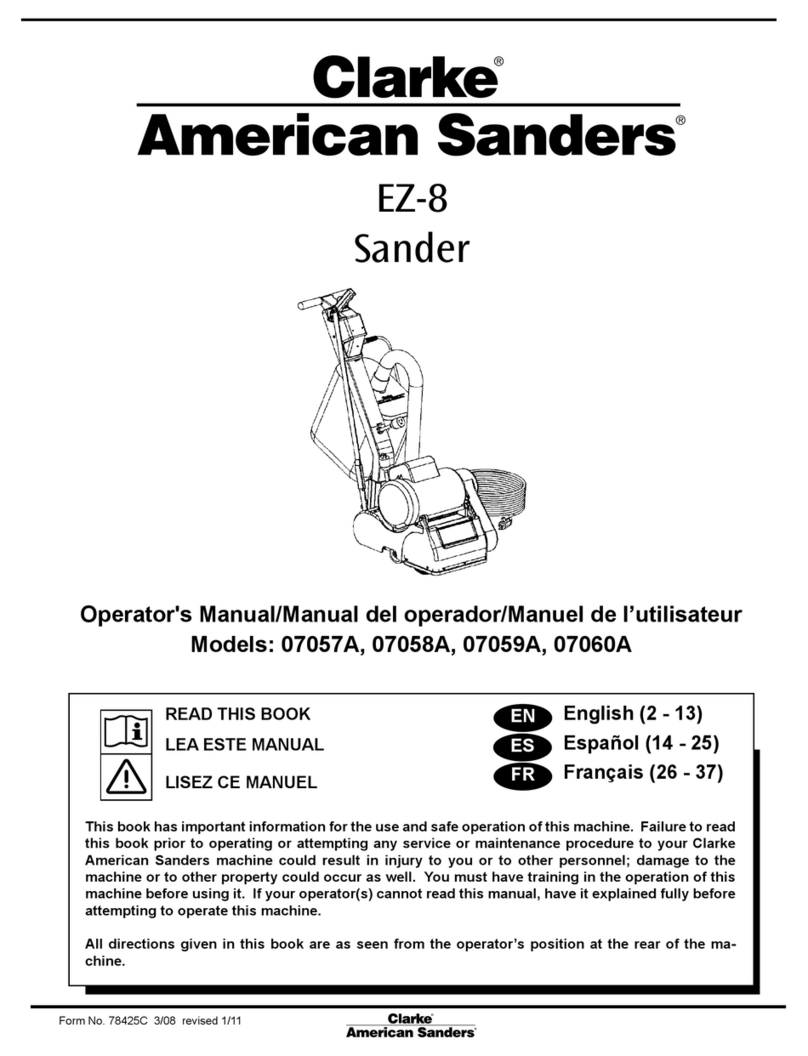
Clarke American Sanders
Clarke American Sanders 07057A User manual

Clarke American Sanders
Clarke American Sanders RS-16 User manual
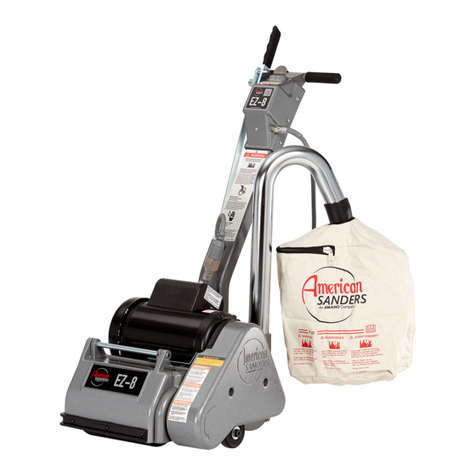
Clarke American Sanders
Clarke American Sanders EZ-8 User manual

Clarke American Sanders
Clarke American Sanders Sander 1600DC User manual

Clarke American Sanders
Clarke American Sanders Super 7R Edger User manual
